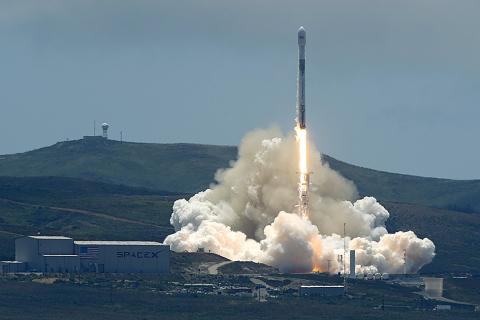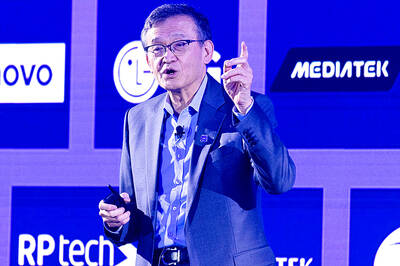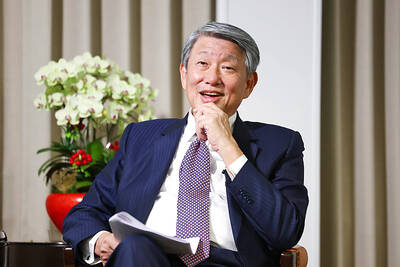Flying cars. Cures for death. And now ... space catapults. Bless you, California, for not letting reality get you down.
On Thursday, a Silicon Valley start-up called SpinLaunch Inc revealed the first details of its plans to build a machine meant to hurl rockets into space.
To achieve that goal, SpinLaunch has secured US$40 million from some top technology investors, founder Jonathan Yaney said.

Photo: AP via NASA
The company remains tight-lipped about exactly how this contraption would work, although its name gives away the basic idea: Rather than using propellants like kerosene and liquid oxygen to ignite a fire under a rocket, SpinLaunch plans to get a rocket spinning in a circle at up to 8,000kph and then let it go — more or less throwing the rocket to the edge of space, at which point it can light up and deliver objects, such as satellites, into orbit.
Yaney is trying to work around the limits that physics have placed on the rocket launch industry for decades. To overcome gravity and Earth’s atmosphere, rockets must be almost perfectly engineered and, even then, can only push a relatively small payload into space.
The items carried on a typical rocket, for example, make up less than 5 percent of the rocket’s mass, with the rest going toward fuel and the rocket’s body.
SpinLaunch’s so-called kinetic energy launch system would use electricity to accelerate a projectile, and help do much of the dirty work fighting through gravity and the atmosphere.
In theory, this means the company could build a simpler, less expensive rocket that is more efficient at ferrying satellites.
“Some people call it a non-rocket launch,” Yaney said. “It seems crazy. It seems fantastic. But we are actually using relatively low-tech industrial components to break this problem into manageable chunks.”
An impressive group of investors have signed on to support Yaney’s vision. The bulk of the US$40 million came from Alphabet Inc’s GV (formerly Google Ventures), Kleiner Perkins Caufield & Byers and Airbus Ventures.
Over the past few years, the rocket industry has become quite crowded. Following in the footsteps of Elon Musk’s Space Exploration Technologies Corp, dozens of companies have appeared, trying to make small, cheap rockets that can be launched every week or perhaps even every day.
These smaller rockets have been built to carry a new breed of shoebox-sized satellites — dubbed smallsats — that are packed full of imaging, telecommunications and scientific equipment.
The small rockets, though, are really just miniaturized versions of the large, traditional rockets that have flown for decades. SpinLaunch is an entirely new take on the rocket launch concept itself.
“We are very intrigued by SpinLaunch’s innovative use of rotational kinetic energy to revolutionize the smallsat market,” Kleiner Perkins general partner Wen Hsieh (謝文暄) said in an e-mailed statement. “SpinLaunch can be powered by renewable energy sources, such as solar and wind, thereby eliminating the use of toxic and dangerous rocket fuels.”
SpinLaunch has a working prototype of its launcher, although the company has declined to provide details on exactly how the machine operates or will compare to its final system.
The start-up plans to begin launching by 2022. It is to charge less than US$500,000 per launch and be able to send up multiple rockets per day.
The world’s top rocket companies usually launch about once a month, and most of SpinLaunch’s rivals have been aiming for US$2 million to US$10 million per launch for small rockets.
If the start-up were able to reach its goals, it would easily be the cheapest and most prolific small launcher on the market.
The company would, of course, need to build its own launch facility and then prove this technology actually works — no small feat.
“We are evaluating five potential launch sites within the United States,” Yaney said.
Yaney grew up in California and has run a variety of businesses, from software makers to construction companies. When it comes to aerospace engineering, he is self-taught, having pored over textbooks in the years leading up to the founding of SpinLaunch in 2014.
The idea of a rocket slingshot seems like science-fiction, and Yaney has nothing resembling the background for a rocket maker.
Still, some experts in the field who have seen the prototype were impressed by Yaney and think the company has a fighting chance.
One such believer is Simon Worden, the former director of NASA’s Ames Research Center and a well-known expert in the aerospace field who is unaffiliated with SpinLaunch.
“It’s a very good approach in my opinion,” Worden said.

Nvidia Corp CEO Jensen Huang (黃仁勳) today announced that his company has selected "Beitou Shilin" in Taipei for its new Taiwan office, called Nvidia Constellation, putting an end to months of speculation. Industry sources have said that the tech giant has been eyeing the Beitou Shilin Science Park as the site of its new overseas headquarters, and speculated that the new headquarters would be built on two plots of land designated as "T17" and "T18," which span 3.89 hectares in the park. "I think it's time for us to reveal one of the largest products we've ever built," Huang said near the

China yesterday announced anti-dumping duties as high as 74.9 percent on imports of polyoxymethylene (POM) copolymers, a type of engineering plastic, from Taiwan, the US, the EU and Japan. The Chinese Ministry of Commerce’s findings conclude a probe launched in May last year, shortly after the US sharply increased tariffs on Chinese electric vehicles, computer chips and other imports. POM copolymers can partially replace metals such as copper and zinc, and have various applications, including in auto parts, electronics and medical equipment, the Chinese ministry has said. In January, it said initial investigations had determined that dumping was taking place, and implemented preliminary

Intel Corp yesterday reinforced its determination to strengthen its partnerships with Taiwan’s ecosystem partners including original-electronic-manufacturing (OEM) companies such as Hon Hai Precision Industry Co (鴻海精密) and chipmaker United Microelectronics Corp (UMC, 聯電). “Tonight marks a new beginning. We renew our new partnership with Taiwan ecosystem,” Intel new chief executive officer Tan Lip-bu (陳立武) said at a dinner with representatives from the company’s local partners, celebrating the 40th anniversary of the US chip giant’s presence in Taiwan. Tan took the reins at Intel six weeks ago aiming to reform the chipmaker and revive its past glory. This is the first time Tan

CUSTOMERS’ BURDEN: TSMC already has operations in the US and is a foundry, so any tariff increase would mostly affect US customers, not the company, the minister said Taiwanese manufacturers are “not afraid” of US tariffs, but are concerned about being affected more heavily than regional economic competitors Japan and South Korea, Minister of Economic Affairs J.W. Kuo (郭智輝) said. “Taiwan has many advantages that other countries do not have, the most notable of which is its semiconductor ecosystem,” Kuo said. The US “must rely on Taiwan” to boost its microchip manufacturing capacities, Kuo said in an interview ahead of his one-year anniversary in office tomorrow. Taiwan has submitted a position paper under Section 232 of the US Trade Expansion Act to explain the “complementary relationship” between Taiwan and the US